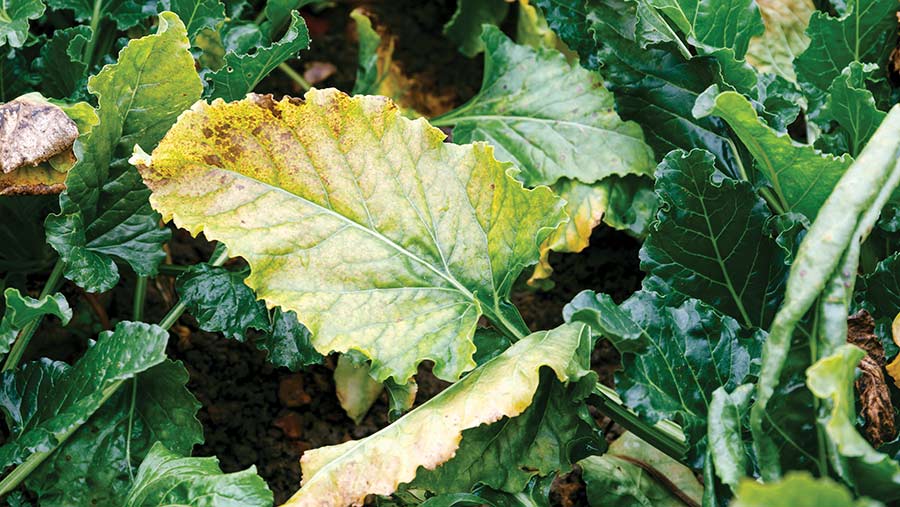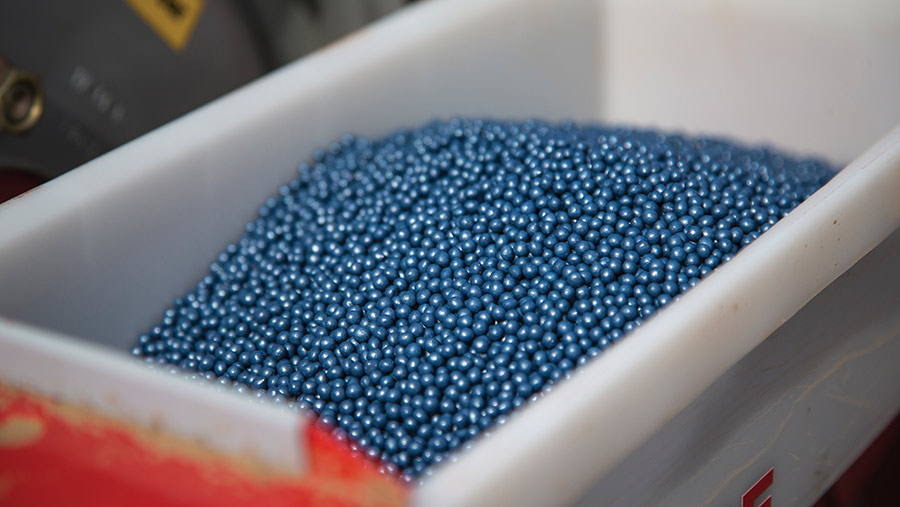What an IPM approach to virus yellows in sugar beet could look like
 © Blackthorn Arable
© Blackthorn Arable Virus yellows is the biggest threat to sugar beet crops in northern Europe, and work is being carried out to develop new integrated pest management solutions to manage the disease.
Dr Alistair Wright, British Beet Research Organisation (BBRO) crop protection scientist, says an integrated pest management (IPM) approach will be key in managing the disease in the long term, as climate change means virus-carrying aphids are arriving 12-15 days earlier in crops.
In addition, there is no certainty on the future emergency use of neonicotinoid seed treatments.
He points to one of the 2022 sugar beet field trials, which was largely yellow in the absence of any control measures. This was a year that wasn’t notable for the disease and highlights the the disease pressure crops can face.
See also: Autonomous sugar beet planting and weeding shows promise
However, he warns that IPM won’t deliver fully clean crops, which is something farmers will have to accept.
“You may see isolated patches in a field and you won’t get control that is as good as neonicotinoid seed treatments.”
But it will avoid the huge losses seen in 2020, he adds.
BBRO head of science Prof Mark Stevens says farmers are already following many IPM principles to manage this costly disease.
These include rapid establishment to get crops to the key 12-leaf stage and using BBRO alerts and forecasts to understand the risk, and indicate when to regularly walk crops to look for aphids and treat them if they reach threshold.
But there could soon be new IPM solutions. Here is what a future IPM approach could include:
1. Good hygiene
One thing growers can do now is to clean up old spoilage heaps and clamps from this harvest, as they can host aphids, says Alistair.
They act as a green bridge along with weeds and root remnants. Other measures include minimising crop volunteers and weed species with well-timed herbicide applications.
2. Grow tolerant varieties
First listed in 2021, Maruscha is the only tolerant variety on the BBRO Recommended List. Alistair says it does stand out in trials, with plots being greener, but there is a yield drag.
Last year’s data shows Maruscha exhibited 25% yield loss to beet yellows virus, much less than the 45% with Daphna. However, Maruscha yielded 85t/ha (adjusted) in the absence of virus, and Daphna achieved 100t/ha.
“Farmers are effectively losing yield before the virus gets into the field. There is a need for better varieties.”
Alistair says they are now seeing better material coming forward from breeders taking part in Project Goliath, which has been looking at novel varieties since 2019.
The new candidate varieties are showing enhanced yield performance in the absence of virus yellows, with yields comparable with current elite Recommended List varieties such as BTS 1915 and Daphna.
“We are seeing significant progress and the next generation will start to be a game changer. We could see these on farm from 2026.”

© GNP
3. Drill with a companion crop
Another measure that has been investigated for several years is companion cropping, following anecdotal reports of less virus being seen where barley nurse crops were planted.
Alistair says they have seen benefits in terms of virus control, but there can be a yield penalty. “You have to spray off the barley early enough to stop crop competition.”

© GNP
4. Deploy attractants and repellants
Brassica strips
This year, the BBRO is investigating in commercial fields whether brassica strips can be used to pull aphids away from the beet crop.
These alternative host crops are being planted either among or around sugar beet fields.
Brassica buffer strips have proved successful in preventing excessive virus infection within the trials, especially in the uninoculated control plots.
Endophyte grasses
An example of a repellent is the use of endophyte grasses and the BBRO is following up some interesting work in New Zealand. It is looking at the use of endophyte grasses to boost natural resistance in the sugar beet crop.
There has been good data to support this theory for soil-borne pests and the BBRO is interested to see if this can be replicated on aphids.
He says initial results show plants stayed greener, but there is the challenge of inter-row competition from the grass.
Wildflower strips
Wildflower strips for beneficials is being investigated, but Alistair says one finding is that they don’t deliver the pollen/nectar early enough to coincide with when aphids are infecting crops. They are also not seeing the benefits within fields with strips.
He questions whether they need to be more permanent and put in place well before the crop.
Dyes
A more novel approach is the use of food-grade dyes to change the reflectance of the soil, as this is how aphids see crops. Alistair has seen progress from one site where there was a decline in aphids in the dyed plots, but he added that numbers in all plots were still above spray thresholds.
This year, the BBRO is looking at how to keep the colour more vibrant for longer, and he sees it as a promising part of IPM.
Odour granules
The BBRO has also started working with French company Agriodor, which has developed perfumed granules that repel pests. These granules could be applied using a slug pelleter.
Alistair says the company’s data shows the granules result in a 10- to 15-day delay in aphids reaching spray threshold. He adds that their spray threshold is lower than in the UK, so the benefits could be even longer here and the BBRO is planning trials to find out.
5. Chemical control
The final step in the IPM approach is chemical control. If farmers follow all the IPM practices and still see aphids above the threshold, they will need to use chemical sprays.
“They may need to get the sprayer out in a high-pressure year,” says Alistair.
The threshold for foliar insecticide treatment is one green wingless aphid per four plants up to the 12-leaf stage. After the 12-leaf stage the threshold is one green wingless aphid per plant.
However, work is now under way to look at whether the spray thresholds need updating (see “Spray thresholds”).
Organic manures reduce virus yellows
Work carried out by the British Beet Research Organisation into soil health has revealed a secondary benefit of applying manures to soil.
In 2020, observations found that in fields where organic manures had been previously applied, crops had less virus.
The percentage of fields with more than 30% of plants with virus was 77% where no organic manures had been applied, compared with 15% for those that did receive them.
BBRO head of knowledge exchange Simon Bowen says they don’t know exactly why manures help, but it could be better crop establishment as a result of improved soil health.
Virus yellows
Virus yellows is caused by three different viruses, with similar symptoms and varying degrees of yield loss:
- Beet chlorosis virus – up to 25% yield loss
- Beet mild yellowing virus – more damaging, with losses up to 30%
- Beet yellows virus – most severe at up to 50% losses.
Spray thresholds
A review of the current spray thresholds is being carried out by Adas, to see if any changes are needed.
Adas senior research entomologist Dr Sacha White explains that the current thresholds are based on 1980s data and sugar beet crops are now being grown differently than 35 years ago.
Sacha says they are looking at how robust the current thresholds are and whether they should be dynamic. For example, should they vary according to factors such as the proportion of aphids carrying disease and crop yield potential.
The work will also highlight any gaps in knowledge that need filling to enable a decision support system to be developed. The project is due to be completed this April.

